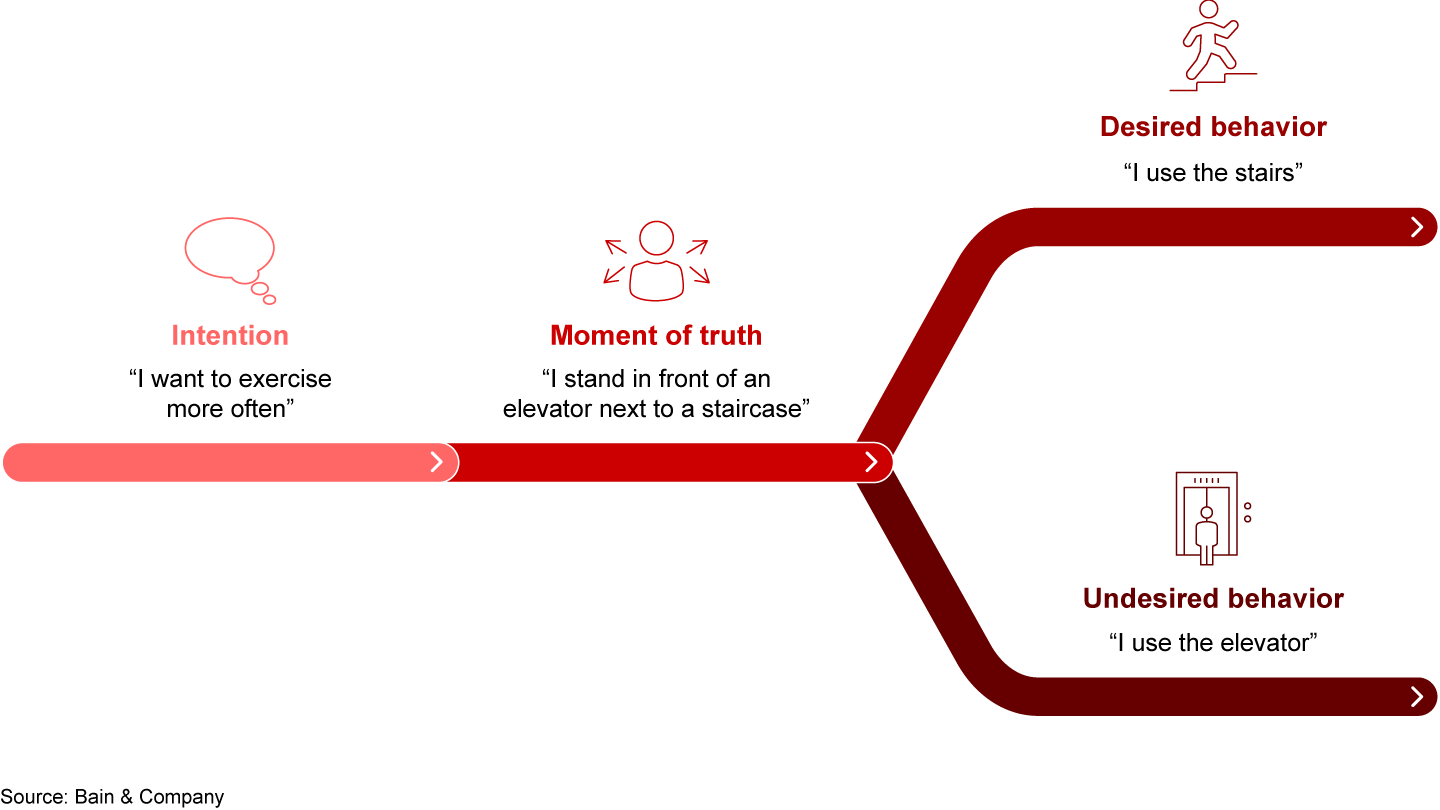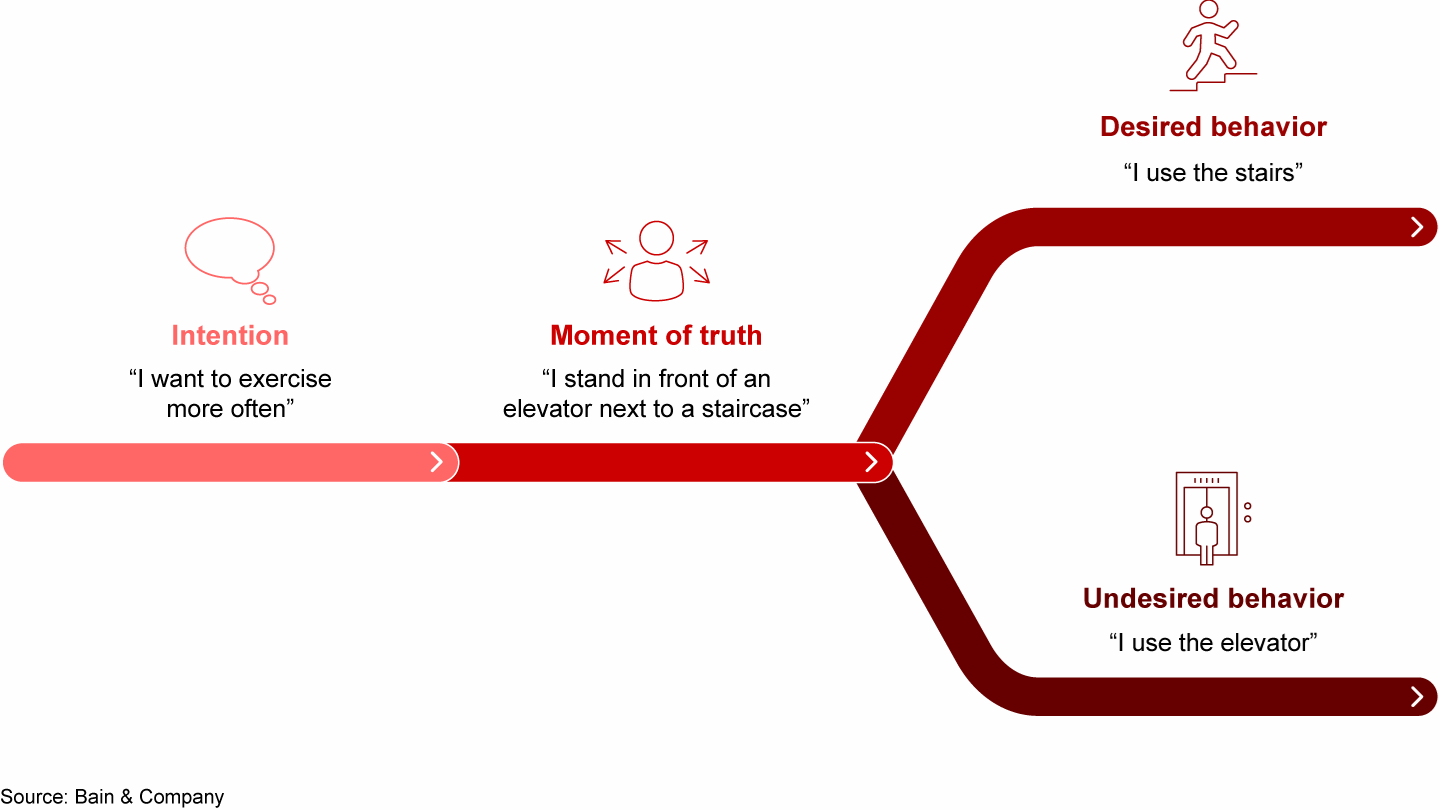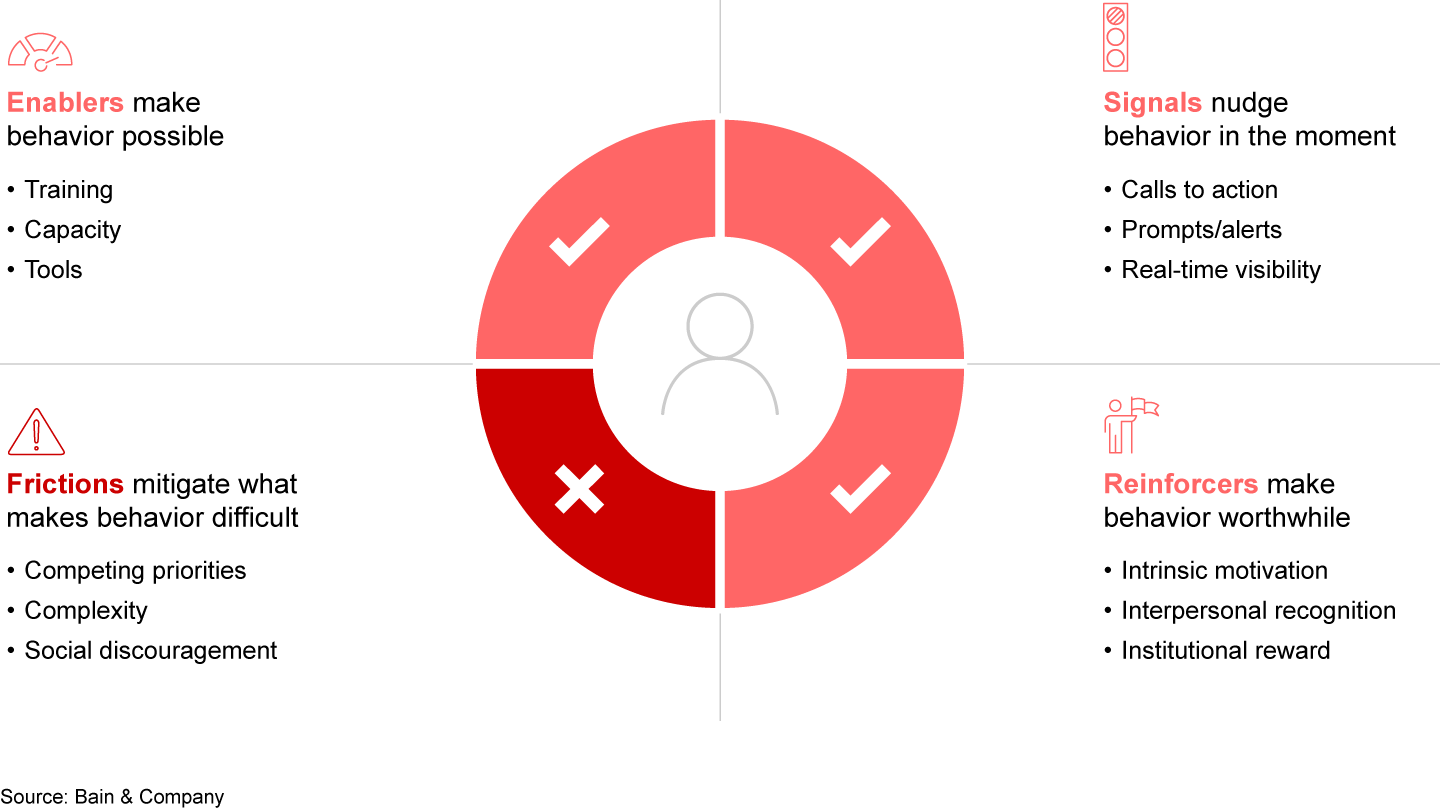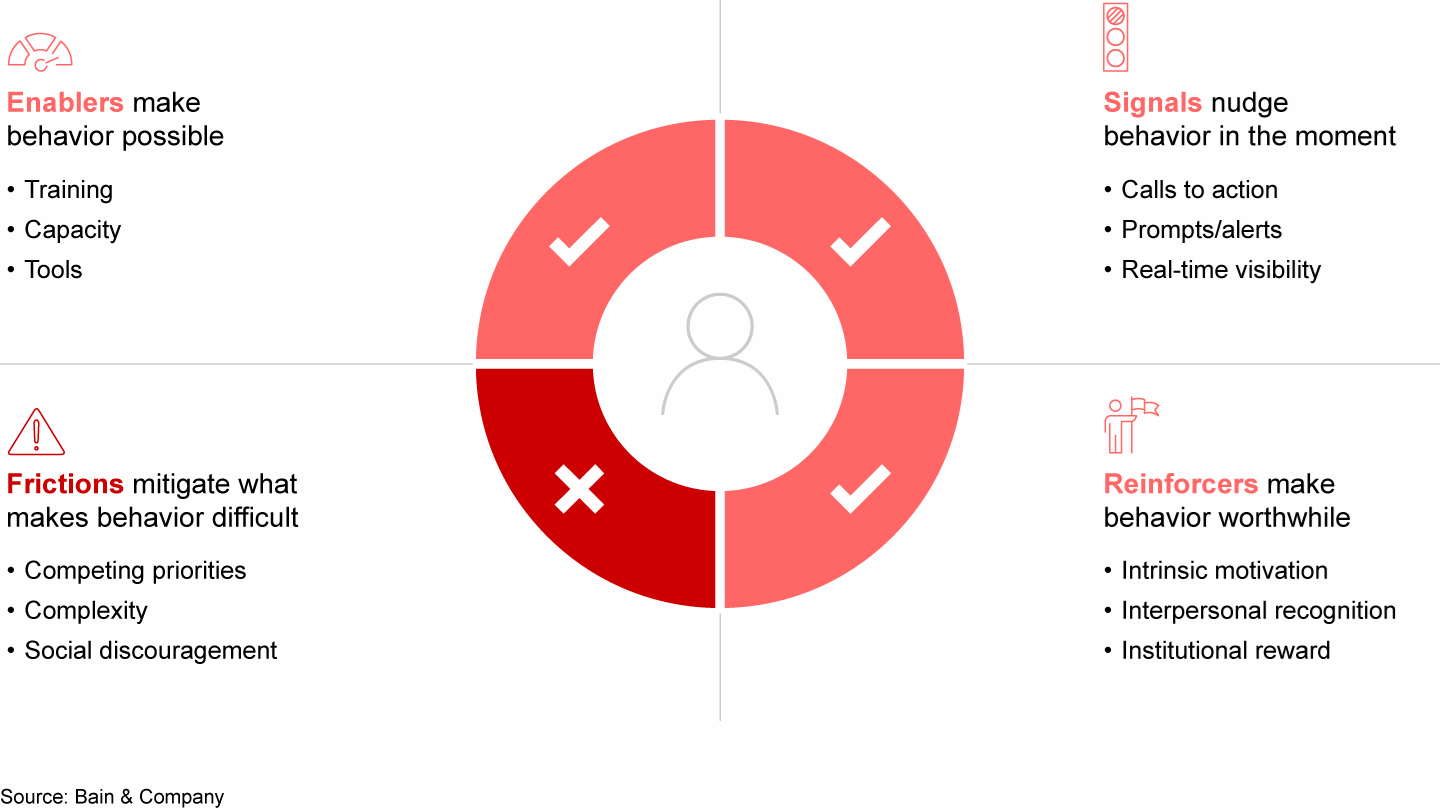Brief

Executive Summary
- When any large-scale organization transformation succeeds, it’s because people have begun to think and act differently.
- Inspiring people to change is an essential leadership skill, but if your go-to tactics are falling short, behavioral science can help you create a change-embracing environment through nudges, feedback loops, and reinforcement.
- The same system for supporting behavioral change can be used for a variety of other undertakings, such as boosting sales team results, enhancing leadership effectiveness, and implementing new operating models.
Whether it’s a strategic overhaul, a merger, an operational enhancement, or any other large-scale project that affects how business is done, one thing is true: Success will depend on people thinking and acting differently. Designing a great organization, process, or system is only the beginning. It’s up to leadership to create an environment in which employees embrace and adopt new behaviors, relieved of the frictions that too often impede adoption and ultimately thwart change efforts.
Consider the case of an established pharmaceutical organization. The senior leadership team believes that the organization needs to become even more customer centric. They sponsor an organization-wide effort that includes mapping customer journeys and embedding customer-centricity practices and behaviors. When tenured account managers hear this, many say things like: “We’ve been successful for 20 years; if it’s not broken, why fix it?” As a leader in the organization who believes in the case for change, sees the opportunity, and is carrying a heavy load of priorities and responsibilities, would you be frustrated when you hear this from your team? Would you be tempted to answer: “Just do it because it’s the right thing,” or even “because it comes from the top?” In this moment, it takes effort for leaders to reframe the situation from “the account managers are resistant, and they need to get on board” to “there might be rational reasons and organizational friction that prevent account managers from fully engaging in this transformation, and I need to work with them to bring them along.”
Organizational change is complex. It depends on hundreds, or even thousands, of people shifting their behaviors in complex and varied contexts. It’s key to design approaches that make it easier and more fulfilling to do the right thing and harder to do the wrong thing.
This starts with focusing on the small subset of all behaviors that produce the lion’s share of results, the ones employees choose during “moments of truth,” when a specific behavior has an outsized influence (see Figure 1). These are pivotal points at which an individual faces a choice between a new, desired behavior and an old one. As employees make the right choice repeatedly over time, they model desired behavior for others. As more and more people choose the desired behavior, a few key moments multiply to outsized effect.
A “moment of truth” is when choosing a different behavior really matters, but it’s really difficult


For example, when a software product owner receives a request from a senior account manager for an unplanned product customization for a major client, should they immediately agree because of who the request came from—or should they assess when (and if) the request aligns with the product backlog and negotiate a different agreement? When an executive hears her team make negative comments about a leadership team decision she initially disagreed with and then committed to support, should she make sure to explain the rationale and stand behind the decision—or should she signal that she thinks it’s not the best decision either but that it can’t be changed, so the team needs to accept it and move on?
Creating an environment that supports desired behaviors in those moments requires that leaders understand that their people often have good reasons for not choosing new behaviors. A new solution may be difficult to learn, or seen as a bad solution, or the organization may still reward old behaviors.
By enlisting team members to help cocreate what great looks like—that is, what we say and do during moments of truth—leaders increase employees’ trust as well as their sense of ownership in the new ways of working. An effective cocreation approach involves listening to the affected employees’ concerns about the barriers preventing them from shifting to new behaviors, and then enlisting them to help design specific, practical steps that will overcome those barriers.
Once those behaviors are agreed upon, leaders need to establish the conditions that will enable them, such as training, signals, or nudges that prompt choice in the moment. Unfortunately, enablers and signals are not enough. Leaders should also address those things that make the new behavior difficult to adopt, such as competing priorities, a lack of leadership alignment, or any other cause of friction. Most importantly, they must reinforce the right choices to help desired behaviors stick. People behave in a certain way because it works for them: It’s easier, faster, safer, or appreciated. It is reinforced. If leaders want to change a behavior to something more aligned with the organization’s long-term goals, but perhaps harder, slower, or more awkward, they must find ways to reinforce the new behavior (see Figure 2). Neglecting to act on frictions and reinforcers means that leaders are asking employees to change without addressing the organizational barriers that make the transformation difficult.
Making the behavior possible requires removing frictions and implementing enablers, signals, and reinforcers


As a leader sponsoring change, ask yourself: “Have I addressed each quadrant of the behavioral change framework?” Back to our earlier example regarding how to respond when an account manager expresses skepticism about our customer-centricity transformation.
- Do we create time for them to engage in learning events to deepen their understanding of customer centricity (enabler)?
- Do we incorporate questions such as “what feedback have we heard from customers?” into our weekly account reviews (signals)?
- Do we take action when account managers point out that the new marketing materials that they were promised to help them address customer needs are late (remove friction)?
- Do we create space to talk about what personally motivates us about customer centricity (intrinsic motivation)?
- Do we take time to notice and appreciate when account managers start to adopt more of the customer-centricity behaviors we discussed and celebrate progress (interpersonal recognition)?
- Do we incorporate feedback about customer centricity into performance reviews and ratings (institutional rewards)?
Behavioral change in action
Having internalized those critical lessons, leaders can turn their attention to the specific steps that achieve lasting behavioral change.
First, identify the behaviors that will help reach the business objective—this could be reducing customer waiting times, cutting service costs, or making more effective decisions—and the critical employees who, by changing their behavior, can make that happen. That population will vary by objective. For example, when a global consumer products leader decided to evolve its operating model, the priority was to ensure that employees who had a key role in specific revamped global processes clearly understood how their mission was evolving and could behave accordingly.
Second, explore and rehearse what great looks like in safe settings. To change behavior, employees need to viscerally feel the tension between desired behavior A and undesired behavior B at key moments. Practicing in an experiential setting can help because it reveals why a person might be inclined to choose B over A and what can be changed to make it easier to do the right thing. After a Japanese conglomerate acquired a US start-up, executives would often default to “Nemawashi,” the practice of going to senior stakeholders individually to respectfully inform them, remove hurdles, and move ahead with the integration. This left the start-up’s staff feeling that important decisions were being made without them, behind closed doors. To resolve this disconnect and facilitate an effective and inclusive integration, the acquirer launched a series of workshops and focused conversations to help both sides better understand the cultural context and reach an agreement about how they would work together during moments of truth.
Third, sprint on new behaviors, and reinforce with feedback loops. The hardest part of change is making new behaviors stick over the long term. Progress tends to slip a few weeks after training, even when people have good intentions about putting the training into practice. Sprints and feedback loops help create momentum and make change last. When top leaders of a nonprofit determined that they could improve decision making by getting more feedback from team members, they had some trepidation about what they might hear, but they were also eager to learn what they were doing well and what they should continue to focus on. They picked two important behaviors and practiced (or sprinted on) each for three weeks. Team members gave weekly anonymous growth-oriented feedback that catalyzed and reinforced the right behaviors—things such as stating individual decision roles at the start of meetings or sticking to one’s defined role. This rapid learning process and closed-loop mechanism helped engrain these new habits into their daily work.
In each of these steps, the role of the leader as change agent cannot be overemphasized. Scaling behavioral change starts with the senior executives and key influencers of the organization walking the walk. Their role doesn’t stop at defining the behaviors but includes modeling, reinforcing, and creating opportunities to amplify the behaviors as the broader organization embarks upon the same journey. At the pharmaceutical company mentioned above, instead of “passing the baton” to the training or communications team once behaviors were defined, leaders stayed engaged and assumed responsibility for bringing everyone along on the journey.
When companies create a culture that supports behavioral change and master the skills to do it, they have a model that can be used repeatedly to advance important new initiatives or to respond to unexpected waves of external change.
The following examples highlight how effective this can be.
Helping leadership teams become more effective
An innovative US bank at the heart of the innovation economy saw that its rapid growth was placing an unfamiliar strain on the organization, with people experiencing more friction, frustration, and discomfort. By 2020, as the bank was incorporating new business lines and putting renewed focus on product innovation, it became clear that the company needed to take stock of how it was operating. The hope was that a new operating model with clearer connections between business units and corporate functions would remove much of the stress and enable employees at all levels to make more decisions and funnel fewer issues to the executive team.
Forging those connections and clarifying decision rights were important steps, but for true change to take hold, many people had to be comfortable with the new ways of working and become role models for change. Building on a history of strong personal relationships and a shared commitment to the mission, its values, and the leadership behaviors necessary for success, the leadership team was determined to lean into moments of truth to bring the new operating model to life.
They began by thinking about which behaviors would be hard to change and why. In discussions, moments of truth emerged. Accelerating the speed of decision making, for example, made sense, but some feared that some decisions, particularly those the team hadn’t faced before, might be relitigated. There was also a clear need to work more effectively across functions, but people worried that other parts of the organization might not commit to the same time frames.
Groups made a conscious effort to align on the different ways they would behave, using the new decision roles as a framing mechanism and common language but diving deeper into the specific actions and conversations that would result. Subsequently, they carved out time in group meetings to openly reflect on whether things were going as intended and to assess the role that each function and individual was playing. Although that marked a new way of operating, everyone appreciated the shared engagement and lack of finger-pointing.
Corporate transformation and behavioral change
Belcorp, a door-to-door beauty products retailer operating in 13 countries in Latin America, had been undergoing a digital transformation when something puzzling happened. Online orders by sales associates had initially ticked up, only to stall for no clear reason. Some digging revealed that one reason of concern among supervisors was that this change would eliminate an important part of their jobs and perhaps make them redundant. The company developed a focused approach to behavioral change that made the case more effectively and helped supervisors identify and address their reluctance, which led to them demonstrating more support for online ordering and encouraging its use by associates.
Results were so promising that the company rolled out the model across its business lines, developing an expertise in behavioral change that helped it strengthen its e-commerce muscle, which would be much needed as Covid-19 hit in early 2020. Although the company’s beauty consultants hesitated at first to push a new online ordering system that allowed consumers to place orders directly, as countries went into lockdown, the consultants realized that the new system would save the business. Because its competitors had not built the necessary digital and logistics infrastructure, Belcorp was able to take the lion’s share of business. Its revenue declined, but the effect was modest given how drastically economies shrank in its markets as successive lockdowns took hold. Its ability to deploy and test digital adoption and the behaviors that support it helped Belcorp react swiftly to an unforeseen global challenge.
Unlocking commercial behavioral change
A major provider of data services was facing shrinking revenue in part because of declining sales productivity. Data analytics and on-the-ground observation identified key behaviors of top-performing salespeople, including spending 2.5 times more time with clients and basing sales on customer needs rather than product availability. Leaders gathered employees from sales and sales operations to cocreate a set of behavioral commitments based on such observations. They also cut down on internal meetings, upped the amount of time supervisors spent on the road, and realigned their training programs, sales toolkit, and incentives to support the behaviors they wanted the sales staff to embrace.
•••
Employees generally want to contribute their best. When organizational change happens, the energy employees can bring to that change is enormous. It’s up to leaders to unlock that potential energy. When employees are inspired to change and have the chance to cocreate and commit to behaviors, energy increases. When leaders remove organizational friction and demonstrate that the company is serious about supporting and reinforcing the behaviors they are requesting, changes stick. Only a systematic approach can achieve behavioral change at scale, enabling people to embrace and maintain new and better ways of working.